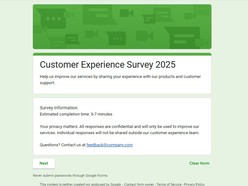Survey and feedback forms are essential tools for collecting valuable insights from customers, employees, and target audiences. These professionally designed Google Forms templates streamline the data collection process while ensuring comprehensive coverage of key feedback areas.
Benefits of Using Survey Templates
Pre-built templates eliminate the guesswork in question formulation and survey structure. Professional layouts increase response rates by presenting questions in logical sequences that maintain respondent engagement. Standardized formats ensure consistent data collection across multiple survey campaigns, making analysis and comparison more reliable.
Templates save significant time during survey creation. Instead of starting from scratch, users can customize existing frameworks to match specific research objectives. This approach reduces survey development time from hours to minutes while maintaining professional quality standards.
Practical Applications
Customer satisfaction surveys help businesses identify service gaps and improvement opportunities. Employee feedback forms provide insights into workplace satisfaction and organizational culture. Market research templates support product development and strategic planning initiatives.
Event feedback collection enables organizers to enhance future experiences based on participant responses. Educational institutions use assessment templates to gather student feedback on courses and teaching effectiveness. Non-profit organizations leverage donation and volunteer feedback forms to optimize community engagement.
Key Elements of an Effective Survey Template
Clear introductions explain survey purpose and estimated completion time, setting proper expectations for respondents. Strategic question sequencing moves from general to specific topics, maintaining logical flow throughout the survey experience.
Mixed question types including multiple choice, rating scales, and open-ended responses provide comprehensive data collection options. Proper validation settings ensure data quality by preventing incomplete or incorrectly formatted responses.
Professional formatting with consistent styling, appropriate spacing, and clear navigation enhances user experience. Conditional logic shows relevant questions based on previous responses, creating personalized survey paths that reduce respondent fatigue.
Privacy statements and data usage explanations build trust with participants. Thank you messages and follow-up information demonstrate professionalism and encourage future participation in research initiatives.




